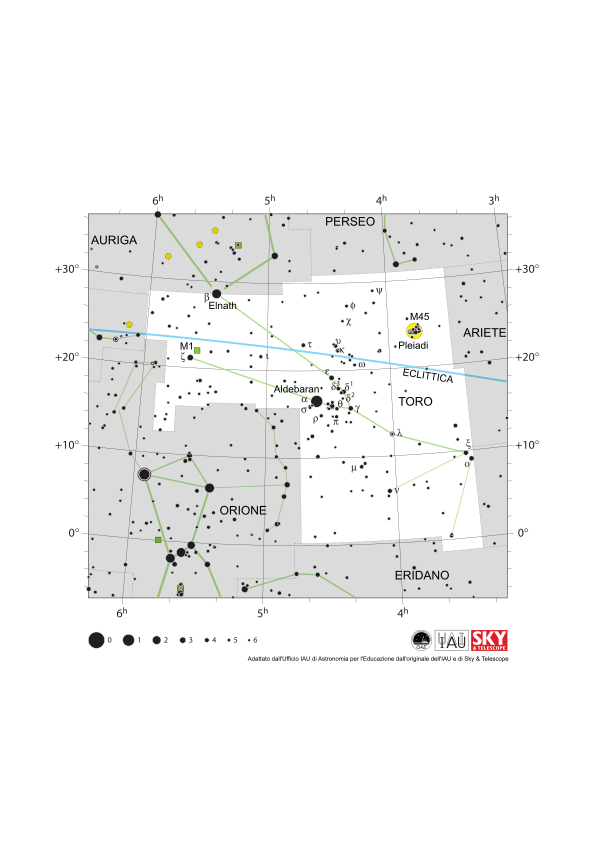This page describes an image Mappa della Costellazione del Toro
Scarica il file PDF (PDF file 209.75 kB)
Diagram caption:
La costellazione del Toro con le sue stelle luminose e le costellazioni circostanti. Il Toro è circondato da (in senso orario dall'alto) Perseo, Ariete, Balena, Eridano, Orione, Gemelli e Auriga. La stella più luminosa del Toro, Aldebaran, appare al centro della costellazione. Il Toro si trova sull'eclittica (qui rappresentata da una linea blu), il percorso che il Sole compie nel cielo nel corso di un anno. Il Sole si trova in Toro da metà maggio a fine giugno. Gli altri pianeti del sistema solare si trovano spesso in Toro.
Il Toro si trova per lo più a nord dell'equatore celeste, con una piccola parte nell'emisfero celeste meridionale. L'intera costellazione è visibile ad un certo punto dell'anno a tutto il pianeta, ad eccezione dell'Antartide e di una piccola regione intorno al Polo Nord. Il Toro è maggiormente visibile la sera nell'emisfero settentrionale in inverno e nell'emisfero meridionale in estate.
Nella parte orientale del Toro si trova il resto della supernova M1 (comunemente nota come Nebulosa del Granchio), qui contrassegnata da un quadrato verde. A nord-est del Toro si trova uno degli ammassi stellari aperti più famosi del cielo, M45 (le Pleiadi), qui contrassegnato da un cerchio giallo. Molte delle stelle vicine ad Aldebaran (ma non Aldebaran) fanno parte di un altro ammasso stellare, le Iadi. Tuttavia, questo ammasso è vicino al sistema solare ed è troppo disperso nel cielo per avere una designazione di oggetto Messier come le Pleiadi.
L'asse y di questo diagramma è in gradi di declinazione con il nord in alto e l'asse x è in ore di ascensione retta con l'est a sinistra. Le dimensioni delle stelle qui segnate si riferiscono alla magnitudine apparente della stella, una misura della sua luminosità apparente. I punti più grandi rappresentano le stelle più luminose. Le lettere greche indicano le stelle più luminose della costellazione. Queste sono classificate in base alla luminosità: la stella più luminosa è etichettata come alfa, la seconda più luminosa come beta e così via, anche se questo ordine non è sempre rispettato esattamente. Le linee tratteggiate delimitano i confini delle costellazioni stabiliti dall'IAU e le linee verdi continue indicano una delle forme comuni utilizzate per rappresentare le figure delle costellazioni. Né i confini delle costellazioni, né le linee che uniscono le stelle appaiono in cielo.
Diagram credit: Adattato dall'Ufficio IAU di Astronomia per l'educazione dall'originale di IAU/Sky & Telescope. Link per i Crediti
Stato di traduzione del Diagramma: Non ancora approvato da un revisore
Traduttori del Diagramma: Giuliana Giobbi
Termini di glossario connessi:
Ammasso aperto
, Ariete
, Ascensione retta (RA)
, Coordinate celesti
, Costellazione
, Declinazione
, Eclittica
, Gemelli
, Magnitudine apparente
, Orione
, Pleiadi
, Resto di Supernova
, Toro
, Zodiaco
Categorie:
Astronomia ad occhio nudo
Diagram license: Creative Commons Attribuzione 4.0 Internazionale (CC BY 4.0) Creative Commons Attribuzione 4.0 Internazionale (CC BY 4.0) icone
In Altre Lingue
Inglese: Taurus Constellation MapSpagnolo: Mapa de la constelación de Tauro
Cinese tradizionale: 金牛座星圖
Cinese semplificato: 金牛座星图
Se noti un errore in questo diagramma, o nella sua didascalia, per favore contattaci.









